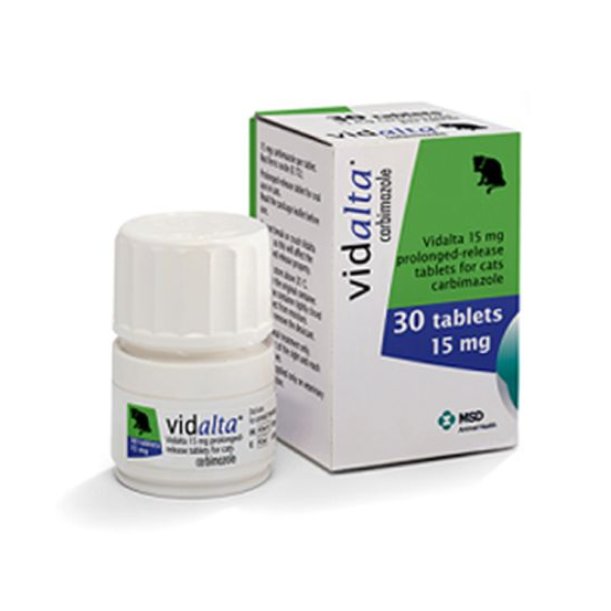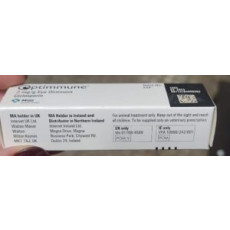Vidalta Prolonged-release Tablets for Cats
Product Description
NAME OF THE VETERINARY MEDICINAL PRODUCT Vidalta prolonged-release tablets for cats. Avilable in 10mg & 15mg tablets
Indications for use for each target species Treatment of hyperthyroidism and hyperthyroidism-associated clinical signs.
3.3 Contraindications Do not use in cats suffering from concurrent systemic diseases, such as severe primary liver disease or diabetes mellitus. Do not use in cats showing signs of auto-immune diseases and/or altered red or white blood cell counts, such as anaemia, neutropoenia or lymphopenia. Do not use in cats with platelet disorders (particularly thrombocytopenia) or coagulopathies. Do not use in cats with hypersensitivity to mercaptoimidazoles such as carbimazole or thiamazole (methimazole) or to any of the excipients. Please refer to section 3.7
3.4 Special warnings Thiamazole (methimazole), the active metabolite of carbimazole, inhibits thyroid hormone production and therefore cessation of treatment with carbimazole will result in a rapid (within 48 hours) return to pre-treatment thyroid hormone levels. Chronic administration is therefore necessary unless surgical or radiation-induced thyroidectomy is performed. A small proportion of cats with thyroid adenoma may fail to respond or have a poor response to treatment. Thyroid carcinoma is a rare cause of hyperthyroidism in the cat and medical management alone is not recommended in such cases as it is not curative.
3.5 Special precautions for use Special precautions for safe use in the target species: Treatment should be adjusted according to a benefit-risk assessment by the responsible veterinarian in each individual case. Treatment of hyperthyroidism may result in a reduction in the glomerular filtration rate. This can lead to unmasking of pre-existent renal dysfunction. Treatment of hyperthyroidism may also induce an elevation of liver enzymes or a worsening of preexisting hepatic disorders. Renal and liver function should therefore be monitored before and during treatment Due to risk of leucopenia or haemolytic anaemia, haematology parameters should be monitored on a regular basis before and during treatment, preferably at each visit of the dose adjustment phase and maintenance phase (see section 3.9). Any animal that suddenly appears unwell during therapy, particularly if they are febrile, should have a blood sample taken for routine haematology and biochemistry. Neutropenic animals (neutrophil counts <2.5 x 109 /L) should be treated prophylactically with bactericidal antibiotics and supportive therapy. Doses above 20 mg have only been trialled in a small number of cats and should be used with caution. Therefore, careful monitoring is recommended and the dose should be adjusted in individual cases following a benefit-risk assessment by the responsible veterinarian
Special precautions to be taken by the person administering the veterinary medicinal product to animals: Wash hands with soap and water after use and when handling litter used by treated animals. Do not handle this veterinary medicinal product if you are allergic to antithyroid veterinary medicinal products. If allergic symptoms develop, such as a skin rash, swelling of the face, lips or eyes or difficulty in breathing, seek medical advice immediately and show the package leaflet or label to the physician. As carbimazole is a suspected human teratogen, women of child-bearing age should wear gloves when handling litter or vomit of treated cats.
Pregnant women should wear gloves when handling the veterinary medicinal product. Do not break or crush tablets. Do not eat, drink or smoke while handling the tablet or used litter. In the case of accidental ingestion, seek medical advice immediately and show the package leaflet or the label to the physician. Carbimazole, as a prodrug of thiamazole (methimazole), may cause vomiting, epigastric distress, headache, fever, arthralgia, pruritus and pancytopenia. Treatment is symptomatic.
3.6 Adverse events Cats: Rare (1 to 10 animals / 10,000 animals treated): Tachycardia; Vomiting, Diarrhoea, Blood in vomit, Oral haemorrhage, Blood in faeces; Azotaemia1 , Elevated liver enzymes2 , Anaemia3 , Neutrophilia3 , Thrombocytopenia3 , Lymphopenia3 , Eosinophilia3 ; Ataxia; Pruritus4 , Dermatitis4 , Erythema4 , Alopecia4 ; Weight loss, Lethargy, Decreased appetite, Pyrexia, Polydipsia, Dehydration; Very rare (<1 animal / 10,000 animals treated, including isolated reports): Disorientation; Polyuria, Renal vascular disorder5 ; Aggression; Dyspnoea; Other abnormal test result6 . 1 Depending on the severity, temporary or permanent discontinuation of treatment may be required. 2 Severe cases may require temporary or permanent discontinuation of treatment. These elevations are usually reversible when treatment is discontinued, although symptomatic therapy (nutritional and fluid support) may be required. 3 May occur in particular during the first 4-6 weeks of treatment. Discontinuation of treatment may be required in case of persistent and marked disorder. In most cases, the abnormality will resolve spontaneously within 1 month after the treatment has been discontinued.
Usually mild, adequately controlled by symptomatic therapy and do not require discontinuation of treatment. However, if more severe clinical signs occur that do not respond to symptomatic therapy, the dose should be reduced or treatment stopped following a benefit-risk assessment by the responsible veterinarian.
5 Treatment of hyperthyroidism may result in a reduction of renal perfusion. 6 Positive antinuclear antibody (ANA). In cases of serious adverse reactions, mortality, possibly due to the veterinary medicinal product, might occur if treatment is not discontinued. In many cases adverse reactions are reversible on cessation of treatment. Reporting adverse events is important. It allows continuous safety monitoring of a veterinary medicinal product. Reports should be sent, preferably via a veterinarian, to either the marketing authorisation holder or the national competent authority via the national reporting system. See the package leaflet for respective contact details.
3.7 Use during pregnancy, lactation or lay Pregnancy and lactation: Laboratory studies in rats and mice have shown evidence of teratogenic and embryotoxic effects of thiamazole (methimazole). The safety of the veterinary medicinal product was not assessed in pregnant or lactating cats. Furthermore, thiamazole crosses the placenta, distributes into milk and reaches approximately the same concentration as in maternal serum. Do not use in pregnant or lactating animals.
Loyalty Scheme
Earn up to 25 loyalty points with this product.







Share
Vidalta Prolonged-release Tablets for Cats
Facebook Twitter Email Pinterest Telegram